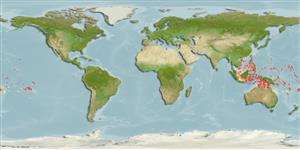>
Anguilliformes (Eels and morays) >
Congridae (Conger and garden eels) > Heterocongrinae
Etymology: Heteroconger: Greek, heteros = other + Latin, conger = conger (Ref. 45335).
More on authors: Böhlke & Randall.
Environment: milieu / climate zone / depth range / distribution range
Ökologie
seewasser demersal; tiefenbereich 21 - 40 m (Ref. 33408). Tropical
Western Central Pacific: Marshall Islands. Eastern Central Pacific: Marquesan and Society islands.
Size / Gewicht / Alter
Maturity: Lm ? range ? - ? cm
Max length : 77.0 cm TL Männchen/unbestimmt; (Ref. 89972)
Diameter to about 20 mm (Ref. 48635).
Life cycle and mating behavior
Geschlechtsreife | Fortpflanzung | Ablaichen | Eier | Fecundity | Larven
Castle, P.H.J. and J.E. Randall, 1999. Revision of Indo-Pacific garden eels (Congridae: Heterocongrinae), with descriptions of five new species. Indo-Pac. Fish. (30):52 p. (Ref. 33408)
IUCN Rote Liste Status (Ref. 130435: Version 2024-1)
Bedrohung für Menschen
Harmless
Nutzung durch Menschen
Tools
Zusatzinformationen
Download XML
Internet Quellen
Estimates based on models
Preferred temperature (Ref.
123201): 26.5 - 28.7, mean 27.9 °C (based on 27 cells).
Phylogenetic diversity index (Ref.
82804): PD
50 = 0.5000 [Uniqueness, from 0.5 = low to 2.0 = high].
Bayesian length-weight: a=0.00102 (0.00046 - 0.00225), b=3.06 (2.88 - 3.24), in cm total length, based on all LWR estimates for this body shape (Ref.
93245).
Trophic level (Ref.
69278): 3.4 ±0.4 se; based on size and trophs of closest relatives
Widerstandsfähigkeit (Ref.
120179): mittel, Verdopplung der Population dauert 1,4 - 4,4 Jahre. (Preliminary K or Fecundity.).
Fishing Vulnerability (Ref.
59153): Moderate to high vulnerability (51 of 100).
